WARNING: As this is a list of episodes, I’m assuming most of my audience are also fans of the show. Hence, there might be some spoilers below. I’ve tried to avoid ruining endings, but I can’t make any promises that some of the details I include won’t upset you in their specificity. So tread cautiously…
HONORABLE MENTIONS

Each season of Community has its own wholly distinct ups and downs, and I’ve heard solid arguments made for each of them. But one advantage of Season 2 is undeniable: it had the best toys. There’s a seemingly endless stretch of spectacular, original concept episodes spread throughout the study group’s sophomore year, none more impressive nor more effectively employed than this one: the claymation Rankin-Bass musical homage. Dan Harmon, in one of the few episodes where he’s directly credited as a writer, takes the warm nostalgic feelings most middle class Americans will already feel towards those old specials, as well as the additional sentimentality afforded to all shows during the yuletide season, and exceeds even that stipend with reckless abandon. Christmas is one of the most sentimental things I’ve ever seen on network TV. It is daringly — nay provocatively — nay conceptually, borderline art-house sentimental. It uses the medium of animation to not-so-subtly illustrate Abed’s fear of growing up, as in a scene where the youngest members of the group, Abed, Annie, and Troy, sit on a life-size model train that’s speeding off into a wintery black unknown while they look for the meaning of Christmas in an imaginary world built from the remnants of their childhood.
Yeah…
First, you have to admire any show, particularly a network sitcom, that even tries to go there. But amazingly they pull it off and still manage to be pretty funny in the process. The episode is meant as a sort of surrogate Christmas special for a cynical, adult audience; drawing on more adult ideas of meaning and family to recreate the unabashedly sentimental warmth those Christmas specials instilled in them as children. Yes, there’s something very specifically Christmasy about that idea, but the more I’ve thought about it, the more I feel that’s something Community tries to do in some way every episode, even if it’s not so obvious about it.
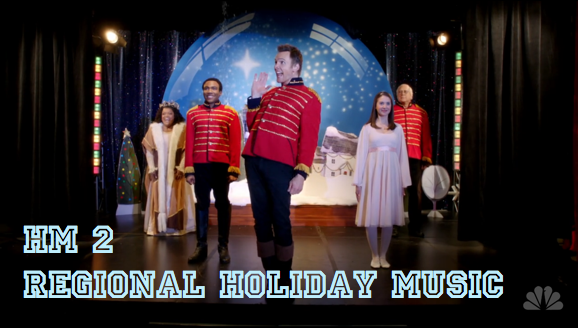
And now for something completely different! One Christmas later, the show dialed down the sentimentality and cranked up the funny to 12 (as in twelve days of Christmas… because twelve is more than eleven… because Spinal Tap… sorry). Still a musical but of a much different variety, Regional also notably delivered the final blow in Community’s ongoing, very one-sided feud with Fox’s hit musical comedy Glee. I’m giving Community the victory because of how awesome and hilarious this episode is. If you want to judge based on other factors, like ratings, or one show running strong while the other’s leader is fired with cancellation all but certain in the next twelve episodes, you might come to a different conclusion. Anyway, while Abed’s Uncontrollable Christmas was more about the animation than the music, and therefore didn’t produce a really catchy tune, this one’s all about the songs and they’re definitely up to snuff. In fact, just talking about them has gotten Baby Boomer Santa stuck in my head — also, strangely enough, Britta’s Christmastime for a Tree interlude. I also love how all the characters are incorporated into the episode by way of the glee club finding ways to pander to them. Really, everything here is built around the concept that Glee is evil. It might make a a lot more people happy than a show like Community, but in reality, all that forced happiness just makes everything darker. So suck on that Emmy’s!
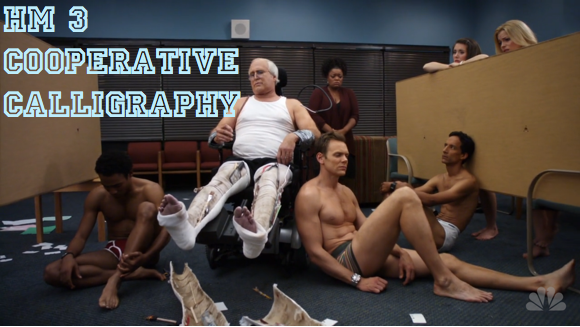
One thing I love about Community is that, despite its seemingly boundless imagination, it’s often at its best working within self-imposed limits. I’m not talking about the tried and true screenwriting principle of defining your world and establishing its rules and boundaries. I’m talking about plain old showing off. The show’s most epic adventure takes place in a single room as a conversation between characters sitting at a table. Its most complex episode only covers two minutes of actual time. Its funniest episode doesn’t even have a narrative. With Calligraphy, the show subjects itself to a more traditional set of boundaries, which Abed is quick to point out as sitcom staple, “the bottle episode.” All the characters are crammed into a single space, forced to deal with a seemingly innocuous conflict: Annie has lost a pen. Eventually, by the rules of bottle episodes, this will become the perfect catalyst for pushing each member of the group to his or her breaking point, revealing the darker sides of their personalities and allowing them to work them out. I love how wholeheartedly this episode devotes itself to the ideas of minimalism and stripping back layers, going all the way around the continuum and eventually looping back to its usual layered self-commentary. Seemingly every action, every prop, every line of dialog is a self-reflexive commentary on the idea of economy. It’s not enough to just have a stripped down episode. The study group must literally strip, first the walls, then the carpet, then eventually their own clothes. And it’s not enough for them to metaphorically air out their dirty laundry for everyone to see. Each character must be forced to literally empty their bags and clothes and reveal what’s inside. It’s the most elaborate possible exploration of simplicity.
THE LIST
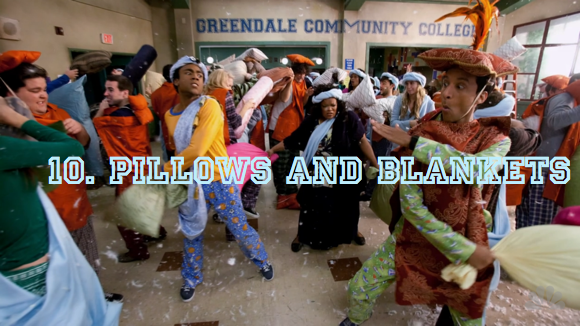
Pillows and Blankets is an homage to Ken Burns’ PBS documentary The Civil War.
Let that soak in for a second.
In fact, I could probably just stop writing here, because anyone who will ever have any interest in a show like Community will know why that idea is empirically amazing. Yet because it gets even better with elaboration, and because I love reading my own writing (lies!) I suppose I should soldier on*. This was a big moment for season 3. Troy and Abed, arguably the series’ most likable relationship, had split up, and whatever episode resolved that conflict had to be something particularly special. The theme of war highlights the gravity of all of Season 3’s major relational rifts, and sort of explains why this season was darker than the more dramatic one that preceded it. The schisms between both Troy and Abed, and Jeff and Annie, aren’t just disagreements; they cut to those characters’ very identities and are essentially irreconcilable. And as the introductory Oliver Wendell Holmes quote points out, “Between two groups of people who want to make inconsistent kinds of worlds, I see no remedy but force.” The writing staff clearly had a lot of fun finding ways to riff on both the civil war and Burns’ special brand of documentary. Most of the communicating takes place through texts and Facebook statuses, which is delightfully clever; and the Ken Burns effect is subtly parodied over and over again, never failing to make me guffaw. The conclusion is also one of season 3’s sweetest moments, resolving the dissension in a satisfying way without downplaying the characters‘ serious flaws. Maybe force is the only real way to resolve some conflicts. But, Community interjects, there’s also invisible magic friendship hats if you’re interested.
* No pun intended… okay, pun intended
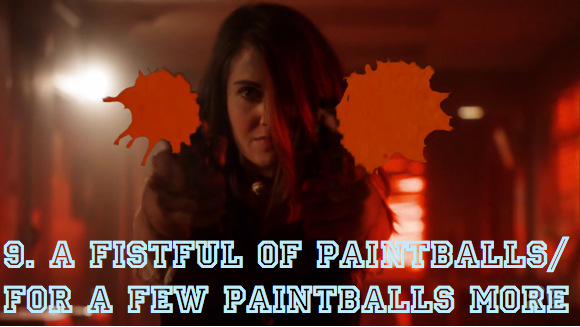
They say you can never go home again. Whatever “they” meant by that, I’m pretty sure Community proves them wrong with this two-part action extravaganza. It was a risky move, returning to the paintball theme that put the series on the map at the end of season 1 — we all know how well a second death star typically compares to the first one — but considering how much of the freedom of Season 2 was afforded by the success of Modern Warfare, I’d say this was a natural place to return at the close. Oh yeah, and it helps that these two episodes absolutely blow the first one out of the water. What made Warfare great was Harmon’s handle on action movie tropes. That’s still present here, and it’s played more confidently for drama than laughs. The spaghetti western theme that dominates the first half of the two-parter also keeps things from getting too “been there, done that,” and gives Harmon a whole new set of conventions and imagery to play around with. (some amazing sight gags include The Good, the Bad, and the Ugly title montage and pretty much everything that happens at Fort Hawthorne) Also, the central conflict here — Pierce’s self-destructive jealousy testing the limits of Annie’s faith — is a much better heart for an action/adventure than Jeff and Britta’s romantic leftovers from the earliest parts of season 1. Maybe a bit of the initial surprise that made Warfare such a treat is gone; and maybe these two episodes aren’t all that funny, whereas Warfare is laugh-a-minute hilarious; but there’s something to be said for a satisfying dramatic finale. Season 1 failed to provide that. Season 2 made damn well sure that didn’t happen again.
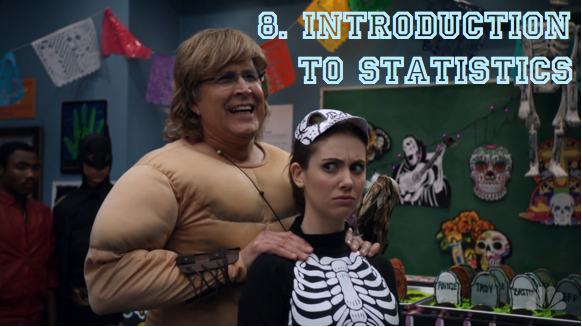
Between Abed’s rambling Bat-monolgues and Pierce’s Beastmaster-themed drug trip, this was a particularly geeky episode for early Season 1. It doesn’t punctiliously connect and reconnect every dot in a mind-numbing web of self-reference, but it’s not exactly devoid of subtext either. And it’s all hilarious, if that’s something you’re into. The occasion is Halloween, and there’s a general theme of “masks” going on. Pierce dresses up as the Beastmaster in a misguided effort to seem cool. Abed is naturally Batman, the best known pop culture reference for the idea of masks. Britta is a chipmunk, a metaphor that makes way more sense when you see her in costume. Annie is a skeleton, though she’s quickly pegged by Britta for “using Halloween as an excuse to dress like a slut.” Shirley is Harry Potter, though her real mask is an overzealous outrage toward Jeff’s new fling, which covers up for her own resentment that her ex-husband has started dating again. And then there’s Jeff as the cowboy — a persona he adopts to seem suave and sexy for the professor he has a crush on, but which backfires when all the townspeople start running to him for help. Yeah, this is what Community looks like when it’s not layered. The weak link is Shirley’s B-story, which doesn’t ring untrue, but just feels more on-the-nose, stock TV drama than the rest of what’s going on. And even that sets up a great sight gag later when she rips the antenna off Professor Slater’s car and waves it around like a wand. Eventually the series would adopt this whole masks thing on a larger scale, adapting whole episodes to fit different genres and themes. Still, this is a great example of how Community never needed paintball or multiple timelines to produce a great episode. A balanced ensemble, a brilliant writing staff, and Jeff imitating Chang in the act of seduction will do just fine.

A central theme of Community Season 3 is control. Jeff’s efforts to maintain emotional equilibrium are a form of control. Annie trying to make everyone better is another form of control. Abed’s determination to keep all these people in his life no matter what is kind of the ultimate form of control. So this episode poses the question: what happens when each of these characters leaves the group for two minutes to let the pizza guy in? It’s fairly straightforward, but executed with particular brilliance. The same two minutes play over and over again until we’ve had time to see what would happen to the group with each character missing. Sometimes Annie and Jeff end up together. Sometimes Troy and Britta end up together. Pierce always finds a way to work in a story about having sex with Ertha Kitt in an airplane bathroom. Each scene builds upon the previous one to create a delightfully improbable symphony of organized chaos.
But that’s only part of the fun. The best thing about this episode is that nothing that happens might actually be real — it all seems to be worst case scenarios reflecting the absentee’s worst fears. Or to add even more meta to the pile, it might be each character’s worst fears as envisioned by Abed, who we now know runs simulations of everybody through the dreamatorium, contains a “worst timeline” within his own head, and who introduces each segment by wondering aloud, “What happened in those other timelines?” When Abed leaves for the pizza, everybody starts fighting so that by the time he has returned, the group looks like they’re about to break up. When Shirley leaves, nobody checks on her pies and they burn, which is kind of mundane, but prompts a great bit of self-reflexive humor where the group has an intervention because they don’t want Shirley’s sole personality trait to be “baking”. But the real show-stopper is Troy’s scene. It’s hilarious on its own, but even funnier when you think of it as a reflection of the way his mind works. His concerns during the whole episode are of a type: he keeps checking on the olives by the toilet, and he obsessively makes sure the rock on his Indiana Jones diorama doesn’t hit the floor. When he leaves, nobody is there to stop the rock. What does he fear will happen if he’s not there to stop the rock? Even among Community fans, I don’t dare spoil that surprise.
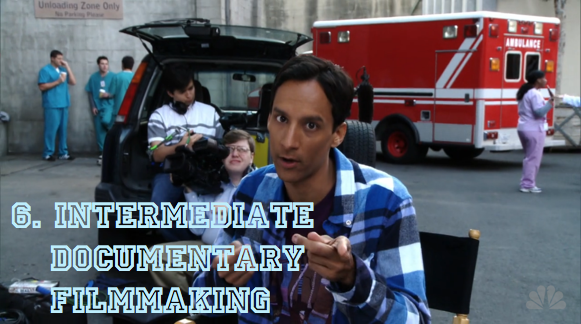
Abed begins this mockumentary parody (mock mockumentary?) by explaining to the camera that he is interested in the documentary format because it allows subjects to explain their actions out loud. This is a distinctly Community type of moment, which Jeff Winger once called, “Taking everything that happens and shoving it up its own ass.” (itself a doubly ironic anecdote when you think about it) And in true Community fashion, something like this works — not because it is sickeningly clever, but because it is also true. This is an episode built around the idea of self-doubt, and what better way to explore such an internal, abstract notion than with a format where the characters can air those doubts verbally? Of course, even Abed doubts whether this is an effective mode of storytelling or just a cheap trick to make subtext easier. Oh Abed!
This also serves as a great comparison for where Community ranks against other, seemingly incomparable shows. Despite being critically acclaimed, Community failed to ever garner award consideration, in part because of how preposterously silly it can be. Yet look at how well it adapts to a categorically understated genre. None of these characters or their relationships have to change at all to fit tonally into something like The Office, despite any superficial notion that the latter is a more accurate representation of life. In fact this is right up there with The Office’s best episodes (and I LOVE The Office season 2). Filmmaking utilizes the rhythms and structure of the genre to maximize the emotional strength of its story; it takes full advantage of talking heads to hold a discussion beyond the bounds of traditional narrative storytelling; it’s filled with great naturalistic character moments like Jeff’s emotional meltdown and Annie’s speech to Pierce about playing favorites; and it does all of these things while simultaneously “shoving them up their own ass.” That’s why it’s allowed to be obnoxiously, self-indulgently clever. You’re allowed to think and act like you’re better than everyone else when that’s actually the case.

On some level, every episode of Community is about Dan Harmon. By his own admission he had a major hand in each aspect of the show’s creation, threatening to quit if things weren’t done exactly his way. That might sound a bit dickish, but without that stubborn resolve — if he were willing to budge even an inch — could the show be nearly as daring or uncompromisingly honest? Take this episode for example. Analysis is a journey into the head of Abed, the character who functions as Harmon’s on-screen surrogate; which means that on some level of meta commentary this is a journey into the mind of the show’s creator. Abed is also uncompromising. He reluctantly allows Annie to join him in the dreamatorium despite the fact that she sports a grating British accent and would rather play “Hospital School,” yet he makes no efforts to hide the fact that it is killing him inside. The dreamatorium is his space where he can live out his visions and imagine the world through his eyes. Everyone else gets the normal world; Annie gets to have on and off romances with Jeff and genuine emotional catharsis in her life. All he wants is control of his little black box. Of course this doesn’t make any sense to Annie. She wants to assume the best in everyone and therefore doesn’t understand why Abed can’t just let her play her own way and empathize with other people like a normal person. So she reprograms the cardboard boxes in the dreamatorium, replacing the Abed setting with Everyone Else. Abed promptly collapses on the floor as though he’s blown a gasket.
I don’t like to pull this card very often, but as someone who shares a lot of personality traits — not to mention disorders — with Abed and Dan Harmon, I can attest to this episode being absolutely genius in its portrayal of an isolated creative mind. Just consider the way Abed calls other people “unremarkables” instead of inferiors, or tells Annie she’s not dumber than he is, “just less able to see what I see.” This is a character who has worked hard not to view himself as superior to everyone else, just like the locker scene reveals he works hard not to view himself as meaningless. There are other pretty scathingly accurate touches, like the way Abed runs Troy down under the guise of honesty to keep him from leaving him, or the way his pretend interactions with Annie focus not on her person but on her sexuality. I could go on and on in that same vein, about how brilliant the dreamatorium turns out to be as a tool for exploring the darker corners of both Abed and Annie’s worldviews, but it’s probably best if you just re-watch the episiode and see for yourself. And you might not get it from my writeup, but this is also a really funny episode. That Troy bit is dark on reflection, when you think about how upset Troy was at Abed saying some of those things about him in Pillows and Blankets, but it’s also one of the funniest moments in the whole season. And the resolution is is also great, proving that the Abeds and Annies of the world really can reach a compromise. I’ll need to remember that if I can ever get an Annie to speak to me.

Community has always felt like a game of Dungeons and Dragons, taking ordinary people in a mundane setting and assigning them archetypal roles in larger-than-life adventures. That’s probably why the idea of role-playing is conspicuously glossed over here. As the game begins, the study group ignores Abed’s painstakingly organized character sheets, indifferently snagging their assignments at random. It’s a clever way to show they don’t really care about the game — they’re only playing because they think Fat Neil’s might kill himself — but it also reveals that this episode isn’t about nuanced social roles or complex ideas. This is the one about big emotions, life and death, love and hate, heroes and villains. In other words, it’s the epic — albeit a pint-sized one that rarely leaves the study room table. This is an important distinction, not just because these are the show’s themes and they’re kind of a good thing to understand, but because this episode totally fails as it relates to the game of Dungeons and Dragons. As someone who has actually played the game (blast, I’ve played this card twice now in two writeups), this sort of bothered me at first. For instance I have some serious objections to Abed’s management style as the Dungeon Master which I would go into in more depth, but I want people to keep reading. Also, the D&D-related humor seemed to fall a bit flat. I’ve made most of these jokes while playing with my friends, and I like to think Harmon and his writers are a cut above our level of humor. This is all grievously beside the point, but if a nerd can’t complain about this stuff with Community, then there really is no place for us in this world.
Fortunately, it’s all for a good cause. In regards to the episode’s true target, fantasy epics like The Lord of the Rings (and the Dungeons and Dragons movie), this might the most accurate and effective of all the theme episodes. It legitimately works as a part of the genre and builds to what I consider the most satisfying and powerful emotional climax of the series. And while I barely crack a smile at Britta’s concern for the social well-being of a small gnome community, I couldn’t stop laughing at Abed’s gnome impersonation. This applies doubly to Chang’s death scene, Pierce’s makeshift evil throne, and any high-angled shot that sweeps dramatically over the study room. You can definitely chalk “fantasy” under the list of genres Dan Harmon can control with his psychic mind powers.
But the real selling point is the drama. This is one of those episodes where it feels like Harmon is airing out his past struggles like an open wound. Pretty much everything that happens feeds into Fat Neil’s self-pity. Any time there’s a dice roll, he is on the losing end. Any time he really wants to believe these people are his friends, he sees Troy condescendingly grinning at him like he’s an alien. And then there’s a moment where Pierce, who has manipulated the game so he is essentially God, demands with a vindictive sneer that Neil’s character, Ducain, be made fat. That moment, paired with its resolution, is a series’ highlight. It doesn’t come across as melodramatic or tonally inconsistent at all. That the show can be as funny as it is and still pull this kind of dramatic moment off is as good an argument as any for why it is one of the greatest TV shows of all time.
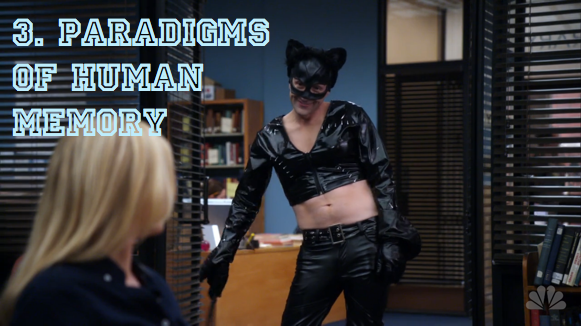
In case you hadn’t figured this out by now, Community is all about drawing parallels: in particular, the parallels between being a community of people and being a TV show. And one thing about both friends and TV shows is that after a while they start to develop recognizable patterns. Everyone has probably had that moment with their inner circle when the things they do, the things they say, the way they spend their time together, all seem trapped in an infinite loop. “We did that yesterday.” “We had this exact same conversation a week ago.” Likewise, TV shows, even ones that are as divergent week to week as Community, start to become predictable as they settle into their established patterns. The Greendale study group is always doing something wacky, non-class related, seasonally appropriate, and oddly humanitarian. The Dean always shows up in a ridiculous outfit with some largely irrelevant news. Jeff Winger always finishes things off with a rousing, somewhat contrived speech.
Hence the fake clip show; the most conceptual and self-reflexive episode of the entire series, which puts it high in the running for most conceptual and self-reflexive episode of any show all time. As the story begins, the group is in the study room making a diorama of themselves in the study room making a diorama. I don’t remember if that diorama is of them making a diorama. It probably is. Anyway, get to the point Charlie Kaufman! Some of us have work in the morning. Eventually the group gets nostalgic and starts reminiscing about events from the previous year, with a small catch: most of the events they describe never took place on the show. They sort of feel like events that might have happened on the show. Pierce steals flu shots from needy children because he thinks it will make him immortal. Troy sinks the group’s raft because he thinks poking a hole in the back will make it go faster. They all visit a western ghost town and are pursued by a racist old man (not Pierce) with a shotgun. These clips are also positioned so that it feels like we’re watching a normal episode of Community, even though almost no true narrative is taking place.
But even this is an illusion. These are broad, barely accurate reconstructions of Community, built from selective memories of its most obvious attributes. That’s also indicative of the group’s memories of each other. For instance, Jeff denies that he and Annie ever really had a “thing” going on between them. Their stolen glances, complete with slow motion and Sarah Barelleis’ sugary sweet song Gravity, are just her perspective of the truth. You arguably could imply the same connection between any two characters, like, say, Pierce and Abed (the show promptly does this). This Rashomon-like challenge to the idea of truth keeps building and building until it crescendoes with the stereotypical Jeff Winger speech, where each sentence is pure non-sequitur delivered in a different outlandish setting (Pierce held at gunpoint by Mexican drug runners is my favorite, narrowly beating out “Harrison Ford is irradiating our testicles!”). It’s all hilarious, maybe the show’s funniest episode, but what’s the point ultimately? If there’s no solace to be taken in idealistic speeches, and any subtle human connections can be a lie, then why even bother? Well, arguably because the idea of these infinite loops is itself a construction. The more time we spend with someone, or some show, the more we take them for granted. Relationships aren’t ever won. They’re an ongoing struggle to hold focus on the actual thing and keep from viewing it as a broad, false construction of itself.
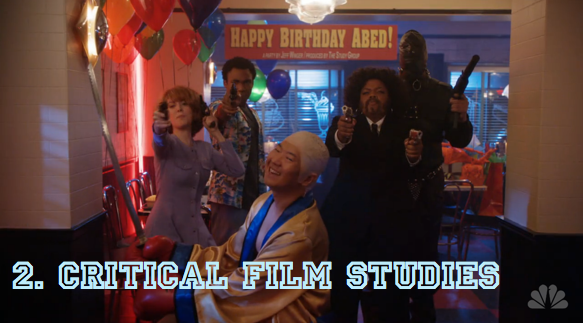
Community’s use of symbolism is its greatest strength. There are many opinions about the show that are open to debate — this is not one of them. Dan Harmon has such a strong grasp on the imagery and patterns of film and television that he can wield them like a poet in his native language. That manipulation of seemingly disposable Americana into a crisscrossing web of symbolism and meaning is at once comfortingly ironic and capable of relaying the depth and gravity of life to a generation that wouldn’t know what to do with a poem if it transformed into a Ferrari and drove over their face in 3D. It’s also the game of another great American artist named Quentin Tarantino (also Walt Whitman, now that I think about it, but Americana was slightly different back when he was around). Harmon is very, very influenced by Tarantino, so it should come as no surprise that Abed, his on-screen surrogate, is equally taken with the trash auteur. Of course, everyone changes. When Jeff rents out a nostalgic diner to throw Abed a Tarantino-themed birthday party, Abed calls him to a fancier restaurant down the street with a much different plan in mind.
I should point out that if you haven’t seen My Dinner with Andre, Louis Malle’s arthouse classic about two friends eating dinner together and nothing else, this episode won’t play nearly as well as it’s meant to. You can understand what that movie is and what it represents; but until you’ve actually seen it, you won’t be able to get just how perfect Abed’s absurd monologue about Cougar Town is, or how director Richard Ayoade’s (Submarine) shot selection perfectly riffs on Malle’s very specific visual patterns. Also you should just see that movie because it’s amazing. It also helps if you’ve seen Pulp Fiction, but who hasn’t seen Pulp Fiction? Anyway, these two movies are the standard bearers of two major approaches in the storytelling world: disposable pop culture and art that tries to facilitate a real, intimate human connection. These might seem like opposites, but in Community they are absolutely inseparable — one is used to convey the other. There’s a closing montage where the cast reenacts scenes from Pulp Fiction to Erik Satie’s devastatingly beautiful Gymnopedie 1. It’s a simple, accessible, but absolutely brilliant symbol to represent everything Community stands for, alongside a lot of great 21st century film storytelling. Maybe Harmon has more in common with Walt Whitman than people give him credit for.

Right now you’re probably thinking, “Wait. Huh?” or “I don’t remember this episode. What movie was it referencing?” or “I’ve been reading this stupid article for how long!?” This is all understandable, particularly the last one, but give me a chance to explain. There’s so much parity among all ten episodes listed here that I essentially tried them all out in the number one spot. Ultimately this one seemed like the least likely coice, which was why I determined it was the right one (now you’re really mad you’ve been reading all this time). More simply, this is my personal favorite: the one I wanted to put at #1 despite the rational parts of my brain arguing otherwise. The romantic part of my brain wants to believe there’s an episode like this for every Community fan; that the big concept episodes are great with their explorations of broad truths about the human condition, but there’s a small, character-driven, otherwise unremarkable episode specifically suited to each individual fan’s own personal demons. Normally I keep that voice tied and gagged in a closet in the basement, but Community is terrible about sneaking into my heart and letting it out.
So where was I? Yes, right, this episode. What time is it again? I should probably go back and point out this is a REALLY good episode on its own. It’s got a bunch of great sight gags (like Abed and Troy’s pet robot) and manages the impossible task of giving everyone in the study group something interesting to do. There’s the C-plot where Abed and Troy work their way through a list of stereotypical college movie experiences Abed wants to have before the end of his freshman year. There’s the B-plot, where Pierce is kicked out of the group after he gets caught up in Abed and Troy’s antics and pantses Shirley. And then there’s my favorite bit from all of Season 1, maybe the whole series, where Britta and Jeff get into an ongoing fight with a bunch of bratty teenagers. I literally paused the show and stood up and applauded during this story, and that was after I recovered from passing out from suffocation after laughing nonstop for like ten minutes. I liked Community before this, but after this episode it was pure love.
And because this writeup isn’t already indulgent enough, let me bring my own high school experience into play for a second. For most of my teenage years, I was what you might define as a loner. I’m sure the other kids in my class weren’t as flat-out inhuman as the maniacal, grunting, satanic imps in this episode — but they certainly seemed that way; not just tangentially. This is what I got out of them, verbatim. It was also enhanced by my own insecurity. Even when I was alone, there were maniacal, grunting, satanic imps yelling “Nyeh!” and “Schmitty!” at everything I did (metaphorically speaking). No amount of Jeff Winger-quality logic or Britta Perry’s earnest humanity could make them go away. They were pure, unfiltered cynicism that sought out all my perceived weaknesses and blared condescending, nonsensical gibberish at them like an angry two-year-old. Anyway, clearly someone behind Community felt the same way.
This exploration of insecurity also feeds back into the idea of age, which is this episode’s central theme. This is such a great Pierce and Shirley episode because Britta and Jeff’s inability to cope with the judgment of these teenagers informs the older characters’ insecurity among the younger members of the group. The older each demographic in the study group gets, the more additional layers of perceived failure can make them forget the wisdom and achievement those years also bring. Which is why it’s great that Abed and Troy’s arc is so silly. This is a story told from an older perspective, so the younger generation seems like they don’t have a care in the world. At the end of the episode, everyone comes together to rally around Jeff and Britta, who Abed points out are “the most insecure members of the group.” The ensuing “schmitty” fight is so wonderful that it probably saved me months of therapy.
But it also really made me care about Jeff and Britta, who at one time in their lives were probably a lot like the cool, soulless teenagers assaulting them. That’s their past selves making faces and copying the things they say as they try to defend the disappointing turns their lives have taken. It’s an acknowledgment that we all grow up and experience failure, and it can be good because we gain empathy and humility from the process. It’s a portrait of life from beginning to end, arranged brilliantly to give perspective to every part of the journey. In other words, it’s what Community does when it’s at its best.
